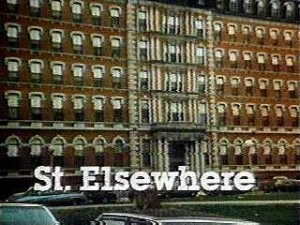 “St. Elsewhere” revolutionized the medical drama with its premiere in 1982. Prior to the release of this show, the genre had no real levity. The doctors were often portrayed as unrealistic heroes fighting against time to save a patient that would eventually be grateful. By the early ‘80s, audiences craved something with a little more intelligence, and thanks to creators Joshua Brand and John Falsey, television history was made.
“St. Elsewhere” revolutionized the medical drama with its premiere in 1982. Prior to the release of this show, the genre had no real levity. The doctors were often portrayed as unrealistic heroes fighting against time to save a patient that would eventually be grateful. By the early ‘80s, audiences craved something with a little more intelligence, and thanks to creators Joshua Brand and John Falsey, television history was made.
St. Eligius Hospital was the fictional teaching Boston medical locale where the series took place. The show centered on a group of young medical students coming to terms with their chosen profession. What was different about it was that it was made known to the audiences that some of these medical students were not fit to be doctors. We see compassion through some eyes and disgust in others, allowing the most human side of the medical profession to reveal itself.
The residents were led by Ed Flanders as Dr. Donald Westphall, a compassionate and just boss. He cares for his residents, patients and family and provided a character that anyone would be glad to work for. Sadly, Flanders committed suicide shortly after the series due to depression, though his career was going so well that it was impossible to what led to it.
William Daniels (“Boy Meets World”) played Dr. Mark Craig, who was the chief heart surgeon. He is the complete opposite of Westphall’s character – pompous and always outspoken. Daniels managed to create one of television’s most beloved characters in his performance because he allowed the audiences to see his many sides. We see a man that tells his patients, students and superiors what he is feeling, especially if it is for their own good.
David Birney is the other leader of the staff, but only on the first season, as his character of Dr. Ben Samuels does not return for a second. Birney was the one and only weak link on the first season, because he initially assumed that the series would focus on him. He was disappointed to discover that the show would be a collaborative effort with many main characters.
Norman Lloyd made a few appearances in this season, only to become a star in the second season, replacing Birney.
The strongest performances from the students came from one unlikely source: Comedian  Howie Mandel  as Dr. Wayne Fiscus. He brought his comedic sensibilities, fine tuned them and created an amazing character. Wearing a baseball cap and a tool belt to house his medical supplies, he walks around the hospital hitting on anything in a skirt. That leads into an interesting love triangle in the season involving a nymphomaniac doctor and a cute nurse.  (Watching Fiscus trying to resist the temptations of the nymphomaniac is priceless.) However, Fiscus isn’t just a carefree flirt – the writers also made him a serious E.R. Doctor, one that added some dimension.
Terence Knox (“Lies”) creates a chilling performance as Dr. Peter White. White is not cut out to be a doctor and the audience watches him slowly fall apart throughout the season. His family life is also slipping, since he can’t afford to pay the bills and seems to have made some bad decisions.
Denzel Washington made his debut as Dr. Phillip Chandler, and it is clear that he had confidence in himself early in his career – Washington gives a strong performance throughout all six seasons.
Add in Ed Begley Jr. (“Amazon Women on the Moon”) and David Morse, and it is easy to see why this season is a classic.
Brand and Falsey wrote a dark but honest first season. Patients died unexpectedly, White’s character is intense and an E.R. doctor gets a bottle smashed on his head, exposing audiences to the unsafe world of the medical practice. “You need to be dedicated to make it in this profession†was a clear message in the season.
The real icing on the cake is that the show was shot extremely well. Comprised of many difficult-to-shoot tracking shots, it is on par with anything in theaters. A scene in the E.R. would be set on a track and would roll across many rooms to cover the many main characters and traumas. This meant each actor had to be prepared, or the whole take would have to be redone, single handedly ruining a couple of hours of work.
Upon viewing, the first season leaves no mystery as to why this is classic television. Each episode is multi-layered, allowing you to find at least one story that will entertain you. And it is so refreshing to revisit this series when reality shows seem to dominate the major networks.
The second season introduces us to new characters, including Mark Harmon as Dr. Bobby Caldwell, who might be the first television doctor to contract HIV. It has been a couple of years since season one was released, and fans have eagerly been awaiting the second. 20th Century Fox should really consider releasing it soon.

Leave a Reply